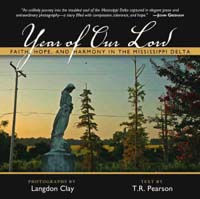Lucas McCarty sings in the choir of the Trinity House if Prayer in Moorhead, Mississippi. Even by unexacting Delta standards, this county church is an eccentric affair. The building occupies an expansive open lot opposite a rice field. There is no proper sign, no steeple, not even a cross by way of identification. …
Sunday services at the Trinity House of Prayer begin in the vicinity of noon and tend to run in excess of three house. The church is unaffiliated with any established denomination. Trinity is sanctified. Except of Lucas McCarty, the congregation is black.
I love the first few paragraphs of the Year of Our Lord: Faith, Hope, and Harmony in the Mississippi Delta by T.R. Pearson and photographed by Langdon Clay, because of how well they set the scene for this short but moving true story.
The book is about Lucas McCarty, a young white man with cerebral palsy who sings in the choir of the all black Trinity House of Prayer Holiness church in the Mississippi Delta. Lucas’s disease keeps him from most facets of a normal life, but he’s found acceptance and even a voice in this particular church.
The book reads like a novella-length magazine piece (is that even a thing?), with Lucas’s story as a way of exploring life in the rural Mississippi Delta. I was struck by the way that Pearson was able to make a comparison between Lucas and the Delta itself:
This was essentially the Lucas I met on that Sunday in June. Not yet twenty-one and properly adult. Chafing against grinding idleness. Ambitions dormant. Not despairing but by no means satisfied. In short, emblematic of the Mississippi Delta at large.
There’s a distinct air of stifled potential among the general population of the Delta. Nagging joblessness is a leading feature of the place. New efficiencies in farming, while improving yields and enhancing profits, have simultaneously closed of opportunities for employment. More acreage than ever is now farmed in the Delta with fewer hands than have ever been needed to farm it.
It was also interesting to read this book as a break in the middle of a much longer book about life in the rural south, The Warmth of Other Suns by Isabel Wilkerson. Wilkerson’s book is a historical look at the migration of African American’s from the south between about 1915 and the late 1960s, but much of the book is set in the same type of poverty still evident today that Pearson and Clay explore in this book.
I was a little disappointed with the way that Lucas was portrayed a little one-dimensionally. He is an inspiring and interesting young man — about the same age as me, so I’m not sure why I keep thinking of him as younger — that is portrayed pretty positively in the book. But then in the last chapter Pearson threw in a few paragraphs talking about some of Lucas’s struggles and dark periods, something not even alluded to earlier in the story. I wish that had been brought up and discussed to make Lucas more well-rounded and acknowledge the difficulty of trying to live with a disease like this one.
That said, I liked reading this story. The photographs helped set the mood, and Pearson’s writing was simple but effective at conveying a story that’s both challenging and hopeful. It was a lovely pre-Christmas read, and worked well as a break in the middle of a longer but similar story.


Comments on this entry are closed.
I just read a book too where all the interesting bits suddenly appeared at the end, and you wish it had been more integrated into the whole story! It’s too bad this one was like that, but it sounds like a nice book anyway!
rhapsodyinbooks: I always think that’s odd, that the interesting conflict gets bumped to the end of a book when it could have been more integrated. But, this was still a nice book, so that’s ok.
I am touched you read my book and you were interested in me. Thank you. Lucas
Thanks for taking time to read my review, Lucas, and for sharing your story. I enjoyed it a lot.